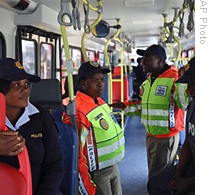Johannesburg
02 September 2009
 |
| Police keep guard inside a bus during the launch of the BRT rapid transit system in Johannesburg, 30 Aug 2009 |
A policeman and a passenger traveling on Johannesburg's fledgling rapid bus system were hospitalized with gunshot wounds after a drive-by shooting late Tuesday, but the modern buses were back on the roads with police escorts.
The new service was launched this week, but struggled with high demand Monday as operators of private minibuses stayed home during the bus system's first day of full operations. Many private operators returned to the streets Tuesday.
Although some private minibus unions support the new system, others are afraid it will hurt their livelihoods.
The secretary-general of one of these, Philip Taaibosch of the National Taxi Council, condemned the attack and called for the arrest of the perpetrators. But he also told national radio that his group must not be edged out of the lucrative industry.
"You cannot continue to exclude the directly affected operators on the basis that you recognize [only] the people you have started with the program [with], " said Philip Taaibosch. "It is good that you started with people, but you must recognize that nobody has an open-ended position within the taxi industry."
A member of the Johannesburg Council on Transportation, Rehana Moosajee, says the government has pledged to partner with the private operators and has already recruited some of their workers to drive the new buses and staff the stations.
"Formal negotiations are indeed ongoing," said Moosajee. "We have reiterated many times that we appeal to all sectors of the taxi industry, those who are working with us, those who remain outside, to come back to government so that we can in fact continue to talk about concerns that may be there."
She said private operators could also play an important role in carrying commuters from outlying areas to stations along the new line.
The $250 million system, called Rea Vaya or We Are Moving, is meant to provide inexpensive, reliable public transportation between downtown Johannesburg and its sprawling suburban townships.
The first phase links the city center to Soweto. The buses travel in reserved lanes and stop at dedicated stations every 500 meters along the 25-kilometer-long route.
The buses run every three minutes during peak hours and every 10 minutes at other times. Their subsidized fares are lower than those of the private minibuses.
On opening day, a supervisor at one of the stations, Asana Ramzah, said the new system was running smoothly despite some teething problems.
"There are a lot of challenges, but hopefully soon we will overcome them," said Ramzah. "A lot of people have been coming. Since half-past four until now it has been busy. Otherwise people are excited."
The routes run near the city's two largest stadiums. The city plans to expand the system to 80 kilometers by next year's soccer World Cup and eventually to 300 kilometers.
Similar rapid bus systems are also planned for other South African cities.
The minibus system began as private cars, or taxis, serving mostly black workers in the townships because of a lack of public transportation during the apartheid era.
The industry today is worth billions of dollars. It still is largely self-regulated and highly competitive. Disputes over routes often become violent. And many commuters complain that bad drivers and unsafe vehicles cause deadly accidents on South Africa's roads.